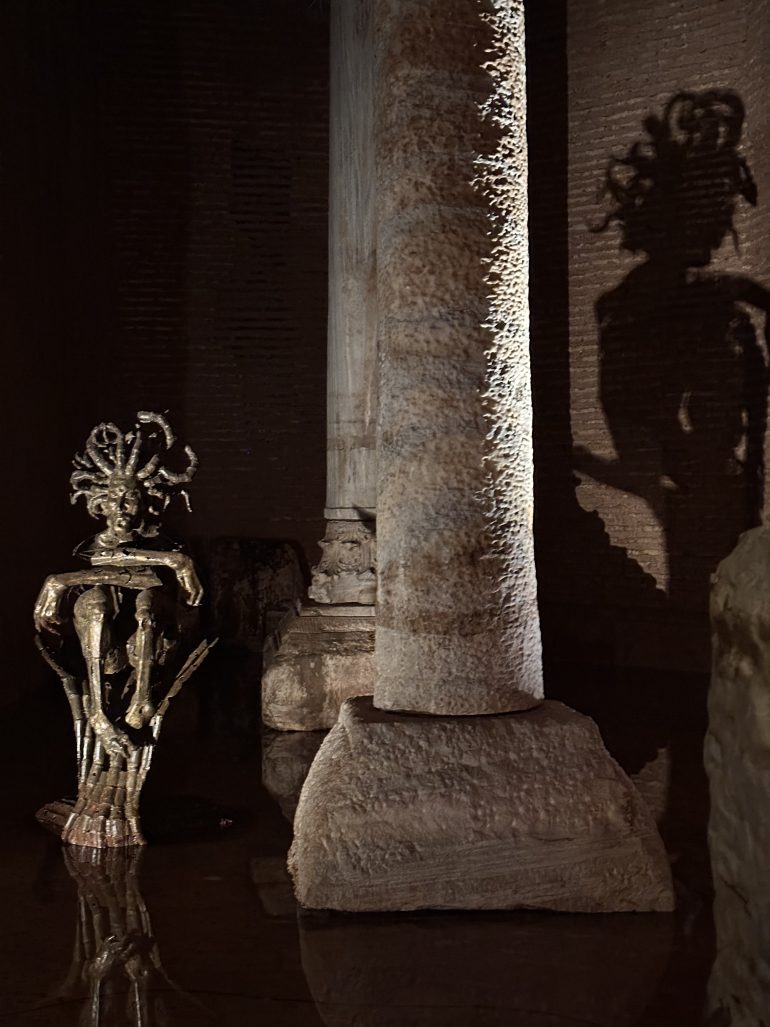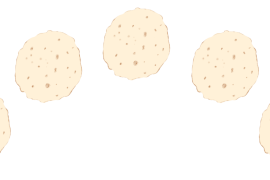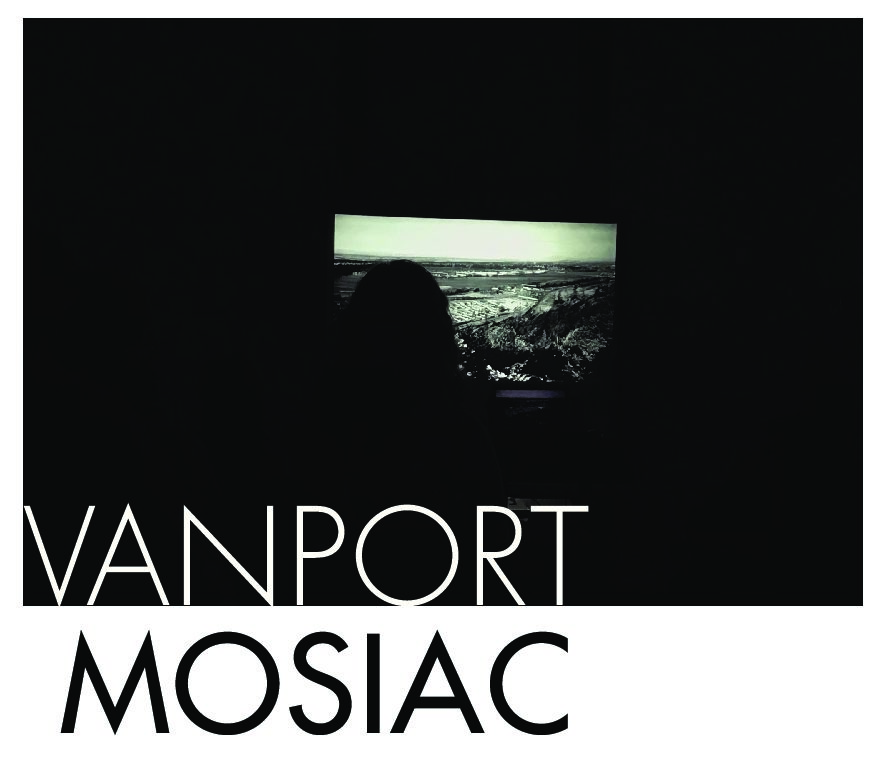It’s hard to navigate the winding and narrow streets of Istanbul. You might get distracted by the ancient walls of Gulhane Garden or the majestic dome of the Hagia Sophia Grand Mosque. But if you muster the courage to journey amidst the throngs of curious tourists, you’ll hear the faint echoes of dripping water and feel the irresistible pull of the city’s hidden underground world. It’s there, in the Basilica Cistern’s shrouded depths, that you’ll encounter the solitary, inverted head of a woman. Her stone eyes and serpentine hair intrigued and terrified me as a child. I didn’t know her name back then, but her presence stayed with me. While my classmates giggled and whispered, I felt an overwhelming sadness for her – trapped, upside-down, and alone in perpetual darkness. It wasn’t until I was introduced to Greek Mythology that I recognized her as Medusa, the tragic figure who turned onlookers into stone with a single gaze.
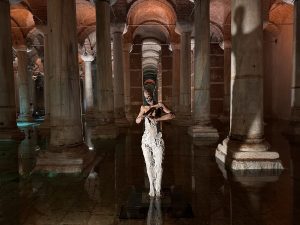
After reading more about the monster recently, I wanted to see the stone head again. However, in 2017, the Basilica Cistern started upon a prolonged renovation, and my visits to Istanbul, Turkey, were too short. Last year, when the Turkish government reopened the Basilica with a new exhibition, circumstances kept me away. After visiting Hagia Sophia and Topkapi Palace, the older Ottoman imperial residence, I came across an endless line outside the Basilica. My husband and I promised to return next year one day early in the morning before the line had a chance to grow long.
My family and I were fortunate to find ourselves in Istanbul again this summer. I said, “Let’s get up early and get to the Basilica early this time.” When my kids asked me, “Where are we going?” I replied, “A place you will remember your whole life. I first visited it when I was your age.”
Early the next day, without breakfast, we left our house in Üsküdar, walked down to the main square next to the sea, and caught one of the ferry boats crossing the Bosphorus. But before boarding, we bought some freshly cooked simits, a kind of Turkish bagel, from one of the bakeries there to eat along the way. From the upper deck, we watched the captivating panorama of old Istanbul from the sea as it passed by. Fifteen minutes later, we had crossed the strait dividing Europe from Asia and arrived at the Eminönü ferry station. From there, we took a streetcar to Sultanahmet, the center of the old city and right next to the new entrance of the ancient cistern. We arrived just after it had opened, and the first wave of early patrons had entered. There was hardly a single person waiting in line.
Before reacquainting myself with Medusa, I immersed myself in the history of the ‘Sunken Palace,’ displayed at the Basilica’s entrance. The grand underground cistern was built by the Eastern Roman Emperor Justinian I (527-565) as part of the new basilica complex in the 530s. The plaques of Yerebatan Sarnici Museum, the cistern’s name in Turkish state, “Although Istanbul is located at the intersection of important waterways, it is a ‘waterless’ city.” This ancient city has relied on external sources for its potable water. A sophisticated system was developed during the Roman-Byzantine era using aqueducts to transport water from the east in Thrace, where fresh water is plentiful. In addition, they built large cisterns to store the water inside the city walls, of which this cistern is the most magnificent example. The waterworks saw further enhancements under Ottoman rule. Following the conquest of Istanbul in 1453, the cistern also provided water for Topkapı Palace. As the area transitioned to urban development, the cistern became accessible to everyone.
‘The Sunken Palace’ has experienced multiple renovations since its construction. During the first major one in modern times, between 1985 and 1987, while digging out all the silt that had accumulated over the centuries, they discovered two iconic blocks used as bases of columns with Medusa heads carved into them. These were some of the most remarkable stone carvings ever found from that time. The cistern was first opened to the public after this renovation, and the heads have been one of the most prominent attractions of the museum.
I didn’t remember where exactly they were when I went down the stairs and entered, but the incredible atmosphere of the cistern had already enchanted me. Although we were in the middle of a scorching summer, there, underground was cool. Visitors’ voices echoed throughout. With the new opening, the museum added a modern exhibition called ‘Deeper Beneath.’ The juxtaposition of the new and the ancient made the Basilica seem even more magical. Ozan Ünal’s ‘Shell, Iron and Concrete’ was the first work on display that welcomed us. Ali Abayoğlu’s ‘Jellyfish Mold Implosion and Hot Fusion’ made me feel as if I was swimming next to it underwater.
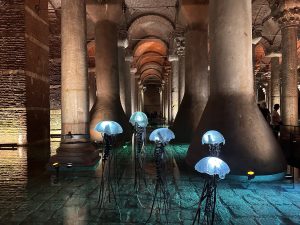
Although the cistern forms a rectangle roughly 450 feet long and 200 feet wide, it’s held up by a forest of 336 marble columns 30 feet high. With every step, I wanted to stop and stare at the water, a shallow layer of which still coats the ground, mirroring the low, subdued lighting and dark ceiling, creating a fantastic symmetry. Guests walk along raised platforms that snake through the site, creating the feeling of being in a labyrinth. My eyes searched for her petrifying gaze. Has she changed in the many years since I saw her last? Did she age? Thirty years later, the stone of Medusa turned upside down was in front of me again. My memory had failed me. I had remembered only one Medusa head, but a second stone head was nearby. A work by Muzaffer Tuncer, ‘Seclusion,’ was placed next to them, waiting for the sightseers.
The sunlight greeted me again as I climbed the stairs out of the cistern. The light overwhelmed my eyes. I took one last look into the deep darkness behind me. It had been worth the beautiful journey.
It was late morning, and now there was a long line in front of the cistern. We left, and headed towards the Blue Mosque. The haunting gaze of Medusa lingered in my mind, as it did when I first saw her when I was nine. I grew up in Istanbul, and had walked along these streets countless times. It was sad to leave the old city, but I’m sure that we will see each other again. But, who knows when.

